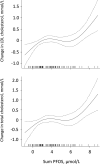Perfluoroalkyl substances (PFASs) and mercury in never-pregnant women of fertile age: association with fish consumption and unfavorable lipid profile
- PMID: 33521539
- PMCID: PMC7841832
- DOI: 10.1136/bmjnph-2020-000131
Perfluoroalkyl substances (PFASs) and mercury in never-pregnant women of fertile age: association with fish consumption and unfavorable lipid profile
Abstract
Objectives: To examine concentrations of perfluoroalkyl substances (PFASs) and lifestyle factors that may contribute to higher levels of pollutants in never-pregnant women of fertile age.
Design: Observational cross-sectional study.
Setting: Participants were recruited among employees and students at Haukeland University Hospital and the University of Bergen, Norway.
Participants: Healthy, never-pregnant Norwegian women (n=158) of fertile age (18-39 years).
Outcomes: Concentrations of 20 different PFASs, mercury (Hg), lead, cadmium, total, high-density lipoprotein and low-density lipoprotein (LDL) cholesterol, in addition to self-reported data on dietary intake.
Results: Seven PFASs were detected in more than 95% of the women. Women aged 30-39 years had higher concentrations of sum PFAS compared with younger women. Serum PFASs were significantly intercorrelated (rho: 0.34-0.98, p<0.001) and six of them were significantly correlated to whole blood Hg (rho: 0.21-0.74, p<0.01). Fish consumption was the strongest predictor for most serum PFASs and for whole blood Hg. Fish consumption and serum perfluorooctanesulfonic acid (PFOS) concentrations were both positively associated with serum total and LDL cholesterol, established risk factors for cardiovascular disease.
Conclusions: The majority of Norwegian never-pregnant women of fertile age had a mixture of seven different PFASs and Hg detected in their blood. PFAS concentrations were higher in older women and associated with fish intake. As the mean age of women at first birth is increasing, several factors require further consideration including diet, as this may influence the burden of PFAS to the next generation.
Trial registration number: ClinicalTrials.gov ID: NCT03272022, Unique Protocol ID: 2011/2447, Regional Committee for Medical Research Ethics West (2011/2447), 12 January 2012.
Keywords: dietary patterns.
© Author(s) (or their employer(s)) 2020. Re-use permitted under CC BY-NC. No commercial re-use. See rights and permissions. Published by BMJ.
Conflict of interest statement
Competing interests: None declared.
Figures


Similar articles
-
Determinants of plasma concentrations of perfluoroalkyl and polyfluoroalkyl substances in pregnant women from a birth cohort in Shanghai, China.Environ Int. 2018 Oct;119:165-173. doi: 10.1016/j.envint.2018.06.015. Epub 2018 Jun 27. Environ Int. 2018. PMID: 29958117
-
Predictors of mercury, lead, cadmium and antimony status in Norwegian never-pregnant women of fertile age.PLoS One. 2017 Dec 5;12(12):e0189169. doi: 10.1371/journal.pone.0189169. eCollection 2017. PLoS One. 2017. PMID: 29206878 Free PMC article.
-
Maternal plasma concentrations of perfluoroalkyl and polyfluoroalkyl substances during pregnancy and anogenital distance in male infants.Hum Reprod. 2019 Jul 8;34(7):1356-1368. doi: 10.1093/humrep/dez058. Hum Reprod. 2019. PMID: 31242507
-
Maternal serum concentrations of per- and polyfluoroalkyl substances and their predictors in years with reduced production and use.Environ Int. 2014 Aug;69:58-66. doi: 10.1016/j.envint.2014.04.010. Epub 2014 May 7. Environ Int. 2014. PMID: 24815340
-
The association between perfluoroalkyl substances and lipid profile in exposed pregnant women in the Veneto region, Italy.Ecotoxicol Environ Saf. 2021 Feb;209:111805. doi: 10.1016/j.ecoenv.2020.111805. Epub 2020 Dec 24. Ecotoxicol Environ Saf. 2021. PMID: 33360787
Cited by
-
Prenatal per- and polyfluoroalkyl substances (PFAS) and maternal oxidative stress: Evidence from the LIFECODES study.Chemosphere. 2024 Jul;360:142363. doi: 10.1016/j.chemosphere.2024.142363. Epub 2024 May 18. Chemosphere. 2024. PMID: 38768789 Free PMC article.
-
Characterizing Important Dietary Exposure Sources of Perfluoroalkyl Acids in Inuit Youth and Adults in Nunavik Using a Feature Selection Tool.Environ Health Perspect. 2024 Apr;132(4):47014. doi: 10.1289/EHP13556. Epub 2024 Apr 29. Environ Health Perspect. 2024. PMID: 38683744 Free PMC article.
-
A review of cardiovascular effects and underlying mechanisms of legacy and emerging per- and polyfluoroalkyl substances (PFAS).Arch Toxicol. 2023 May;97(5):1195-1245. doi: 10.1007/s00204-023-03477-5. Epub 2023 Mar 22. Arch Toxicol. 2023. PMID: 36947184 Review.
-
Association between fish oil supplements use and serum per- and polyfluoroalkyl substances (PFAS): Results from the National Health and Nutrition Examination Survey.Environ Res. 2022 Dec;215(Pt 1):114205. doi: 10.1016/j.envres.2022.114205. Epub 2022 Aug 30. Environ Res. 2022. PMID: 36049507 Free PMC article.
-
Perfluoroalkyl Mixture Exposure in Relation to Fetal Growth: Potential Roles of Maternal Characteristics and Associations with Birth Outcomes.Toxics. 2022 Oct 28;10(11):650. doi: 10.3390/toxics10110650. Toxics. 2022. PMID: 36355941 Free PMC article.
References
Associated data
LinkOut - more resources
Full Text Sources
Medical
Research Materials
